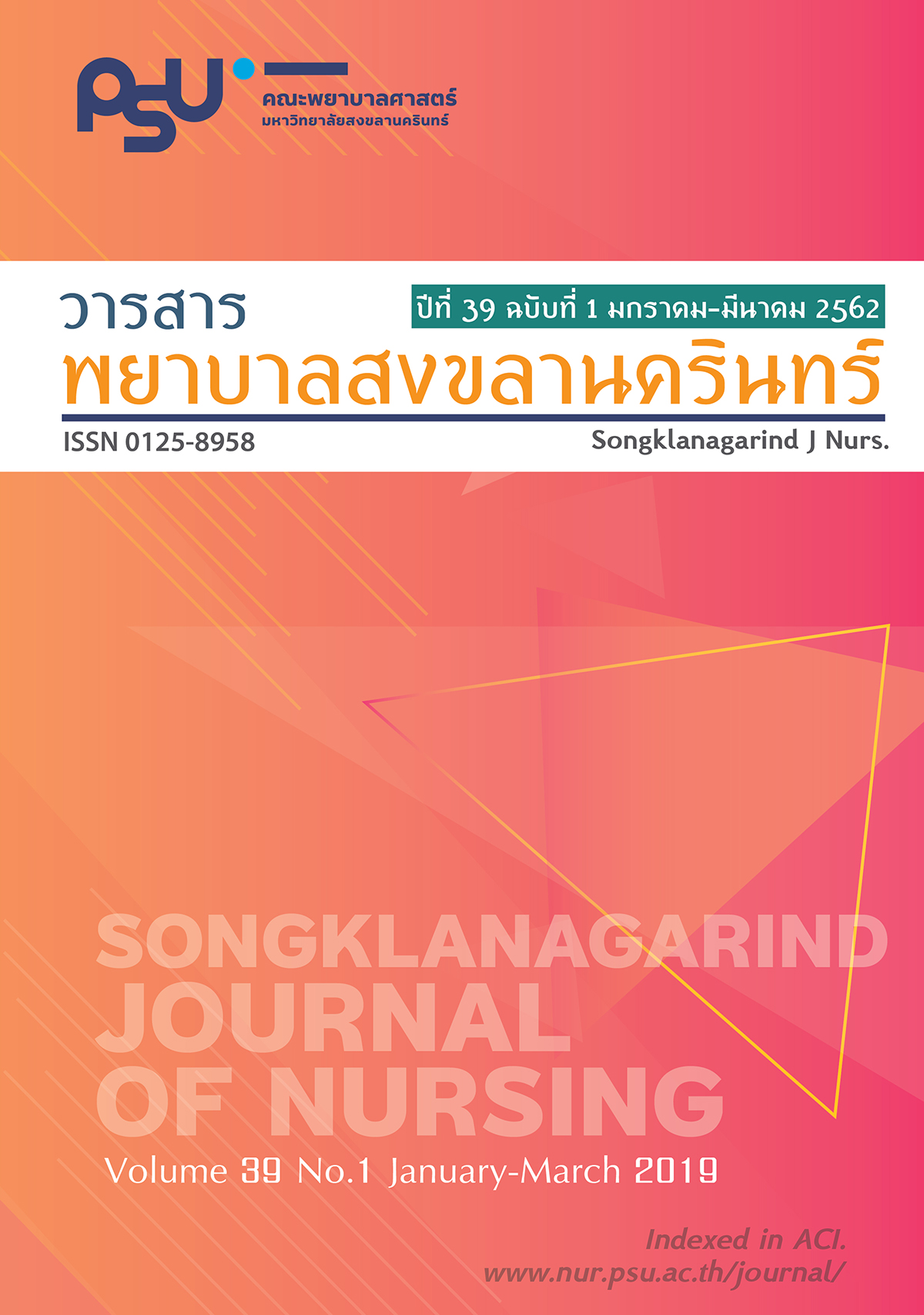Nurses’ Grief in Caring for Patients with Advanced Cancer: A Literature Review
Main Article Content
Abstract
This article aimed to present factors influencing nurses’ grief in caring for advanced cancer patients, consequences, and coping mechanism. A literature review was conducted through steps of creating PICO (Population, Intervention, Comparison, and Outcome) questions, searching, apprising, analyzing, and synthesizing the evidences. Relevant literature from electronic databases (PubMed, Proquest, CINAHL, and Science Direct) were searched using the following keywords: ‘nurses’ grief’, ‘advanced cancer patient’, ‘coping management’, ‘oncology nurses’, ‘grief resolution’, ‘grief therapy’, ‘bereavement’, and ‘mourning’. Twenty one studies were selected based on the following inclusion criteria: publication date from years of 2011 to 2017, discussing about nurses’ grief, English language, full text, and academic journal. Analysis of content were done using matrix table and the articles were appraised based on recommendation of Joana Briggs Institute Critical Appraisal Tools (2016). Findings revealed several factors influencing nurses’ grief; relationships with patients, nurses’ personal factors, delivering care to the patients, institutional factors and patients’ conditions. Consequences of nurses’ grief included compassion fatigue, psychological and emotional stress, burnout, sleep disturbances, and disenfranchised grief. Coping management of grief were peer storytelling, distancing from the situation, normalization, emphasizing the positive things, and maintaining contact with the bereaved families. Results of this literature review found limited intervention to help nurses cope with their grief. Therefore, further study about the interventions to support nurses in dealing with professional grief should be designed.
Article Details
References
Smit C. Theories and models of grief: Applica-1. Smit C. Theories and models of grief: Applica- tions to professional practice. Whitireia Nurs Health J. 2015; 22: 33-7.
Houck D. Helping nurses cope with grief and compassion fatigue: An educational intervention. Clin J Oncol Nurs. 2014; 18(4): 454–8.
Penz K, Duggleby W. ‘It’s different in the home..” The contextual challenges and rewards of pro- viding palliative nursing care in community settings. J Hosp Palliat Nurs. 2012; 14(5): 365-73.
Wisekal AE. A Concept analysis of nurses’ grief. Clin J Oncol Nurs. 2014;19(5): E103-7.
Adwan JZ. Pediatric nurses’ grief experience, burnout and job satisfaction. J Pediatr Nurs. 2014; 29: 329-36.
Barbour LC. Exploring oncology nurses’ grief: A Self-study. Asia‑Pacific J Oncol Nurs. 2016; 3(3): 233-40.
Carton ER, Hupcey JE. The forgotten mourners: Addressing health care provider grief-A Systematic review. J Hosp Palliat Nurs. 2014; 16(5): 291-303.
Wilson J, Kirshbaum M. Effects of patient death on nursing staff: A literature review. Br J Nurs. 2011; 20(9): 559–63.
Polit DF, Beck CT. Essentials of Nursing- Research: Appraising Evidence for Nursing Practice. 8th ed. Philadelphia: Lippincott Williams & Wilkins; 2014.
Shimoinaba K, O’Connor M, Lee S, Kissane D. Losses experienced by Japanese nurses and the way they grieve. J Hosp Palliat Nurs. 2014; 16(4).
Conte TM. The lived experience of work-related loss and grief among pediatric oncology nurses. J Hosp Palliat Nurs. 2014; 16(1): 40-6.
Wenzel J, Shaha M, Klimmek R, Krumm S. Working through grief and loss: Oncology nurses’ perspectives on professional bereavement. Oncol Nurs Forum. 2011;38(4): E272-282.
Wilson J. Ward staff experiences of patient death in an acute medical setting. Nurs Stand. 2014;28(37): 37-45.
Boerner K, Burack OR, Jopp DS, Mock SE. Grief after patient death: Direct care staff in nursing homes and homecare. J Pain Symptom Manage. 2015; 49(2): 214-22.
Anderson NE, Kent B, Owens RG. Experiencing patient death in clinical practice: Nurses’ recollections of their earliest memorable patient death. Int J Nurs Stud. 2015;52:695-704.
Melvin CS. Professional compassion fatigue: What is the true cost of nurses caring for the dying? Int J Palliat Nurs. 2012; 18(12): 606-11.
Carter PA, Dyer KA, Mikan SQ. Sleep disturbance, chronic stress, and depression in hospice nurses: Testing the feasibility of an intervention. Oncol Nurs Forum. 2013; 40(5): E368-73.
Rice KL, Bennett MJ, Billingsley L. Using second life to facilitate peer storytelling for grieving oncology nurses. Ochsner J. 2014; 14: 551-62.
Cook K, Mott S, Lawrence P, Jablonski J, Grady MR, Norton D, et al. Coping while caring for the dying child: Nurses’ experiences in an acute care setting. J Pediatr Nurs. 2012; 27: e11- e21.
Funk LM, Waskiewich S, Stajduhar KI. Meaning- making and managing difficult feelings: Providing front-line end-of-life care. Omega. 2013; 68 (1): 23-43.


